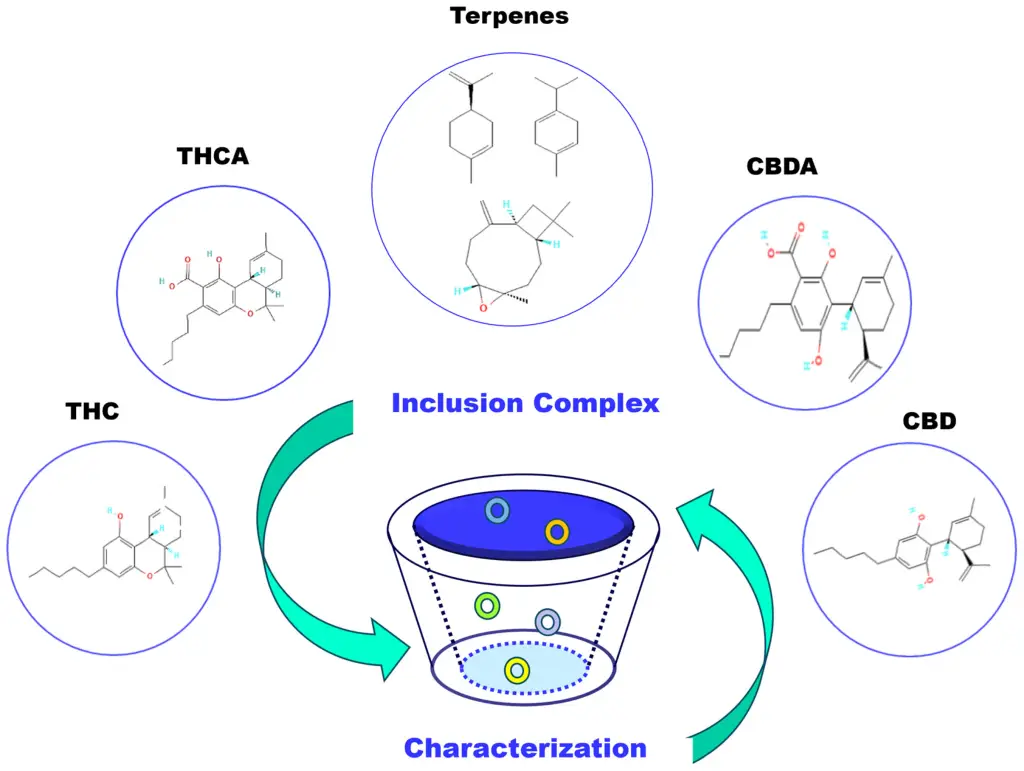Chronic pain, including cancer-related pain, affects over 2 billion people worldwide. Managing such pain is one of the greatest challenges in modern medicine, significantly affecting patients’ quality of life and placing a substantial burden on healthcare systems. Although conventional pain relief medications, such as opioids, are widely used, they often come with severe side effects, potential dependency issues, and variable efficacy. As a result, there is a pressing need for safer, more effective alternatives.
In recent years, cannabinoids — natural compounds derived from Cannabis sativa — have emerged as promising candidates for pain management. Compounds such as tetrahydrocannabinol (THC) and cannabidiol (CBD) are renowned for their analgesic, anti-inflammatory, and therapeutic properties. However, their medical use faces significant challenges due to their poor solubility in water, low bioavailability, and instability.
To overcome these obstacles, researchers are exploring cyclodextrins (CDs) — specialized molecules capable of enhancing the delivery and effectiveness of cannabinoids. A recent study published in Molecules (MDPI) investigates the potential of cyclodextrin inclusion complexes to improve the pharmacological performance of cannabinoids and associated terpenes. This innovation could pave the way for more effective cannabinoid-based therapies for chronic pain sufferers.
The Challenges of Cannabinoid Therapies
Cannabinoids like THC and CBD are lipophilic molecules, meaning they dissolve well in fats but poorly in water. This characteristic severely limits their absorption in the human body. When consumed orally, much of the cannabinoid dose is degraded in the digestive tract and liver before reaching the bloodstream — a phenomenon known as first-pass metabolism. This leads to low bioavailability, meaning only a small percentage of the administered dose reaches systemic circulation to produce therapeutic effects.
Additionally, cannabinoids are chemically unstable and prone to degradation when exposed to light, oxygen, or high temperatures. These challenges hinder the development of consistent, reliable cannabinoid-based treatments for chronic pain.
To address these issues, researchers have turned to drug delivery systems that can protect cannabinoids, improve their solubility, and enhance their absorption.
What Are Cyclodextrins (CDs)?
Cyclodextrins are cyclic oligosaccharides — ring-shaped sugar molecules derived from starch. They have a unique structure with a hydrophobic (water-repelling) inner cavity and a hydrophilic (water-attracting) outer surface. This structure allows CDs to form inclusion complexes with hydrophobic molecules, such as cannabinoids.
When a cannabinoid molecule enters the hydrophobic cavity of a cyclodextrin, it becomes encapsulated and shielded from the external environment. This process offers several benefits:
- Increased Water Solubility: The encapsulated cannabinoid becomes more soluble in water, improving its absorption in the body.
- Enhanced Stability: Cyclodextrins protect cannabinoids from environmental degradation caused by light, oxygen, or heat.
- Improved Bioavailability: Enhanced solubility and protection lead to more efficient absorption, allowing for lower doses and more consistent therapeutic effects.
- Controlled Release: Cyclodextrins can facilitate the controlled release of cannabinoids, ensuring prolonged therapeutic effects.
The Study: Cyclodextrins and Cannabinoid Complexation
The research published in Molecules focused on forming cyclodextrin complexes with key cannabinoids (THC and CBD) and selected terpenes — aromatic compounds found in cannabis that contribute to its therapeutic effects. Specifically, the study investigated the inclusion of cannabinoids with the following terpenes:
- D-Limonene (LIM): Known for its citrus aroma and anti-inflammatory properties.
- Beta-Caryophyllene (BCP): Recognized for its pain-relieving and anti-inflammatory effects.
- Gamma-Terpinene (γ-TPN): Exhibits antioxidant and antimicrobial properties.
The researchers aimed to enhance the solubility, stability, and overall pharmacokinetic profiles of these compounds by forming cyclodextrin inclusion complexes.

Key Findings
- Improved Solubility: The study demonstrated that cannabinoids and terpenes encapsulated within cyclodextrins exhibited significantly improved water solubility compared to their free forms.
- Enhanced Stability: Cyclodextrin inclusion protected the cannabinoids and terpenes from oxidative and thermal degradation.
- Synergistic Effects: When combined with terpenes, the cannabinoids displayed enhanced therapeutic potential, likely due to the “entourage effect” — a phenomenon where cannabinoids and terpenes work synergistically to boost each other’s efficacy.
These findings suggest that cyclodextrin-based formulations could lead to more effective cannabinoid therapies, particularly for chronic pain management.
Implications for Chronic Pain Management
Chronic pain patients often face limited treatment options. Opioids, while effective, come with significant risks, including addiction and overdose. Cannabinoids offer a safer alternative but are hindered by poor bioavailability and inconsistent effects.
Cyclodextrin-based cannabinoid formulations could revolutionize pain management by:
- Providing Consistent Relief: Improved bioavailability ensures that patients receive predictable, reliable doses.
- Reducing Side Effects: Lower doses may be required to achieve therapeutic effects, minimizing potential side effects.
- Enhancing Patient Compliance: More effective and reliable treatments encourage better adherence to therapy regimens.
This advancement is particularly promising for cancer-related pain, where effective and safe pain management is critical for improving quality of life.
Future Directions
While the study shows great promise, further research is necessary to bring cyclodextrin-based cannabinoid therapies to clinical practice. Future work should focus on:
- Clinical Trials: Testing these formulations in human patients to confirm their efficacy and safety.
- Innovative Delivery Systems: Developing advanced delivery methods, such as sublingual sprays, oral capsules, and transdermal patches.
- Regulatory Approval: Navigating the regulatory landscape to ensure these therapies meet safety and efficacy standards.
Conclusion
The use of cyclodextrins to enhance cannabinoid therapies represents a significant leap forward in chronic pain management. By improving the solubility, stability, and bioavailability of cannabinoids, cyclodextrins could unlock the full therapeutic potential of cannabis-derived compounds. This innovative approach offers hope to millions of chronic pain sufferers seeking safer, more effective relief.
As research progresses, cyclodextrin-enhanced cannabinoid treatments may soon become a cornerstone of modern pain management, transforming how we approach chronic and cancer-related pain.
The journal Molecules also published a study revealing the potential of cannabigerol in combating pain, inflammation, and cancer.

